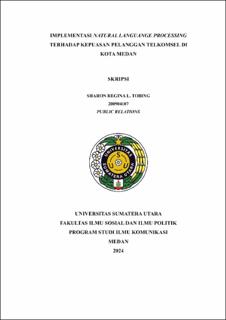| dc.description.abstract | This research is entitled Implementation of Natural Language Processing on Telkomsel
Customer Satisfaction in Medan City. The purpose of this study is to determine the
relationship between the use of chatbot as a virtual customer service to Telkomsel customer
satisfaction in Medan. This research uses a correlational quantitative type. This research
uses new media theory, which is closely related to network theory. Network theory in the
context of new media emphasizes interconnectivity and information exchange in digital
networks. This research collected data with questionnaires and literature studies. The
research sample amounted to 100 respondents with the criteria of Telkomsel users and had
used Veronika Service at least once. The data analysis technique in this study is single table
analysis, cross table analysis, and hypothesis testing using the Spearman correlation test.
A chatbot is a form of Natural Language Processing designed to understand human and
computer forms of communication. Virtual customer service like Veronika is becoming a
new technological tool that provides satisfaction to customers in a manner similar to onsite
customer service The use of Veronika chatbot as Telkomsel's virtual customer service is
a manifestation of this concept, where artificial intelligence (AI) technology is integrated
into a digital customer service network. One of the main advantages of Veronika is its
unlimited availability. The 24/7 service offered by Veronika provides convenience for
customers, allowing them to get help whenever and wherever they are. This feature is highly
valued by users, especially in emergency situations or when help is needed outside of
normal business hours. The hypothesis test results in this study are 0.00 <0.05, meaning
that the two variables have an effect on each other with a correlation coefficient value of
0.867, meaning that the relationship between the two variables is very strong. | en_US |


